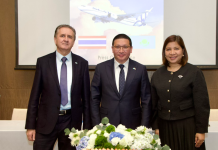BANGKOK, 25 July 2025: Thailand is roaring back on the world tourism stage, leading Southeast Asia’s bold recovery and showcasing a powerful combination of strategy, sustainability, and regional cooperation.
According to the latest data from the UN Tourism, the Asia-Pacific region welcomed 316 million international arrivals in 2024, marking an 87% recovery from pre-pandemic levels. Thailand’s performance has been robust, with the Tourism Authority of Thailand (TAT) reporting a 30% increase in international arrivals during the first half of 2025 compared to the same period last year. Source markets in Europe performed positively, while visitors from China to Thailand declined.

“This is more than a recovery — it’s a renaissance,” said TAT Governor Thapanee Kiatphaibool. “Thailand’s rebound reflects a national effort to reimagine tourism for a sustainable, resilient future.”
Regional unity has been a cornerstone of this progress. ASEAN’s coordinated response — including seamless cross-border travel, joint visa schemes, and destination marketing — is helping position Southeast Asia as a unified tourism zone. The ASEAN Tourism Strategic Plan 2016–2025 continues to provide a strong framework for innovation, workforce development, and inclusive growth.
According to the Pacific Asia Travel Association, Southeast Asia now accounts for over a third of all international arrivals to the Asia-Pacific region. Thailand, Indonesia, and Vietnam are among the top performers driving visits to destinations in the Asia-Pacific region.
Travel analytics firm ForwardKeys has also ranked Thailand as one of Asia’s top-recovering destinations, with bookings for Q3 and Q4 2025 already surpassing those of 2019.
Thailand is also investing heavily in smart tourism infrastructure and sustainability. The recently launched Thailand Green Tourism Plan 2030 includes eco-certifications, digital immigration, and low-carbon transport initiatives. Education remains central, with new training programmes designed to upskill the tourism workforce in digital marketing, customer service, and sustainability leadership.
Meanwhile, in stark contrast, the US President’s “America First” policy has raised concerns among global tourism leaders. The US Travel Association reports that international arrivals to the US remain 18% below 2019 levels, particularly from Asian markets, due to prolonged visa delays, reduced airlift, and unclear policy direction.
“While Asia builds bridges, the US risks pulling up the drawbridge,” said Skål International Bangkok’s President James Thurby. “In today’s interconnected travel landscape, regional cooperation and open engagement are vital. Thailand and ASEAN understand this — and the world is taking notice.”
World Tourism Day, to be hosted in Malaysia on 27 September under the theme “Tourism and Peace,” will highlight the region’s efforts to build a more inclusive and sustainable tourism future.
As Q4 approaches, the outlook remains positive for Thailand and the wider region. Airline capacity is expanding, traveller confidence is up, and the ASEAN brand has never been stronger.
Standouts
Thailand’s international arrivals up 30% in H1 2025; substantial gains from China, India, UK, Russia, and the Middle East
Asia-Pacific’s tourism recovery reaches 87% of pre-pandemic levels in 2024 (UN Tourism)
Thailand, Vietnam, and Indonesia lead ASEAN’s resurgence (PATA, ForwardKeys)
ASEAN unity and seamless travel arrangements accelerating cross-border tourism growth
Thailand Green Tourism Plan 2030 positions country as a regional sustainability leader
America First policy could slow US inbound recovery; Asia continues to lead globally.
World Tourism Day 2025 to be held in Malaysia on 27 September, themed “Tourism and Peace”
About ASEAN
The Association of Southeast Asian Nations (ASEAN) is a political and economic organisation of ten countries located in Southeast Asia, which was formed on 8 August 1967 by Indonesia, Malaysia, the Philippines, Singapore and Thailand. Since then, membership has expanded to include Brunei, Cambodia, Laos, Myanmar and Vietnam. Its aims include accelerating economic growth, promoting social progress and sociocultural development among its members, protecting regional peace and stability, and providing opportunities for member countries to discuss differences peacefully.

About the author
Andrew J Wood is a respected travel writer, hotelier, and tourism lecturer with over four decades of experience in Southeast Asia’s hospitality and tourism sectors. A former general manager of several leading hotels in Thailand and a regular speaker at international tourism forums, he is widely recognised for his insight into emerging travel trends and his passionate advocacy for Thailand as a world-class destination.






